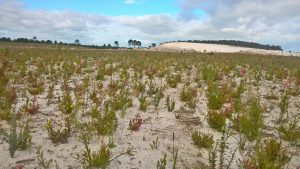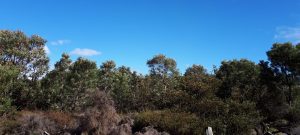Hanson Construction Materials (Hanson) Gaskell Avenue Sand Operations covers an area of 1300Ha within the Swan Coastal Plain. Part of the mining of the coastal dune system includes rehabilitating the excavated areas. Hanson made the decision to restore these areas back to native vegetation local to the area, that being Banksia woodland. As Banksia woodlands are renowned for their inorganic and hydrophobic soils, once stripped from the initial topsoil, there is little to no organics left leaving it extremely difficult to restore the main species of Banksia woodlands. As part of the rehabilitation process, Hanson collects their own seed from the surrounding local plant communities before being cleared and the seed is then either propagated into seedlings and/or used for broadcast/direct seeding back onto the excavated areas.
Hanson works in conjunction with the Botanical Gardens and Parks Authority (BGPA), also known as Kings Park, who conduct research projects and trials to ensure rehabilitation criteria and best environmental practices are met. The first major research program into Banksia woodland restoration commenced in 1995 at the original Gaskell Avenue site, and through community interest, the managing and restoring of Banksia woodlands has been ongoing due to the funding provided through compliance needs in the resources industry. This has enabled major advances to be made in the science and technology of restoration of Banksia woodlands. Monitoring programs are also set up and conducted on an annual basis, recording data from 1, 3, 5, 10 & 20 year old rehabilitation sites. This is to track the progression of the rehabilitation and if there needs to be any adaptations or changes to certain areas.

Image: early stage of rehabilitation
A key research finding as a result of this partnership, was that restoration principles for Banksia woodlands are site specific. The challenge has involved habitat-matching to ensure that local provenance seed of the correct floristic type is replaced. Operational practice also had to be transformed since, unlike many ecosystems elsewhere (e.g. North America and Europe), plant ecological succession patterns do not occur in Banksia woodland – that is, what is restored in the first year remains the fingerprint for species composition into the long term. A priority in developing restoration principles has been to achieve the highest possible seedling recruitment levels in the first year of restoration. A high degree of human intervention is also necessary, to ensure naturally-migrating weeds do not out-compete the native species.
Restoring Banksia woodland communities in post-pine forest areas (resulting in some of the first net-habitat increases) has also been and continues to be another challenge and ongoing learning experience for both Hanson and BGPA. Managing post-pine topsoil as compared to native topsoil comes at a cost due to lack of regeneration of native species, weed invasion and high alkaline soil properties that do not mimic native soil composition. Post-pine removal and rehabilitation trials continue to be monitored closely in order to seek out strategies to eliminate the barriers for restoring these sites back to native vegetation communities (Banksia woodlands) along the Gnangara Water Mound and Swan Coastal Plain.

Image: mature rehabilitation site at Gaskell
Hygiene management plays a beneficial part in the succession of Banksia woodland restoration as it is susceptible to Phytophthora Dieback, which will knock over a whole ecosystem in a short amount of time. The soil-borne water mould disease invades and destroys the function of root systems of native vegetation. The primary cause of spread of Phytophthora Dieback is uncontrolled traffic movement and clearing/stripping operations, water run-off into surrounding vegetation and illegal site incursion i.e. motorbikes, 4×4, horses and foot traffic. The same uncontrolled activities are also the primary cause of weed invasion. Management actions have been put into place to minimise the spread of both Dieback and weeds which are both present at Gaskell Quarry. These actions include ensuring all employees on site are Greed Card Certified through the Dieback Working Group’s training program, and adhering to appropriate clean-down procedures for both light vehicles and heavy operating machinery. Through our Hygiene Management, we are able to control these measures put in place in order to minimise the spread of both Dieback and weeds on site.
Hanson works beyond compliance to ensure best rehabilitation practices are upheld in restoring Banksia woodlands. Hanson conducts tours regarding rehabilitation practices thereby maintaining a strong working relationship with all government bodies and the surrounding community. The relationship between Hanson and Kings Park reinforces the positive effect on how science and operations can work concurrently towards best environmental practices for both restoration and mine closure planning. For more information on best practice restoration techniques, please refer to the “Banksia Woodlands: A restoration guide for the Swan Coastal Plain”; a book published based on the knowledge derived from the 20 year collaboration of research and development between Kings Park and Hanson.
UDIA WA was pleased to participate recently in a site tour of the Hanson Gaskell site.